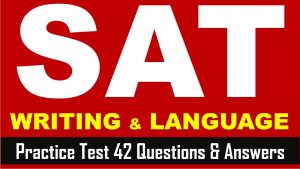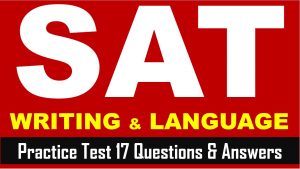Hi SAT Aspirants, welcome to AKVTutorials. As you know SAT (Scholastic Assessment Test) is a standard test, used for taking admission to undergraduate programs of universities or colleges of United States. SAT is developed and published by the College Board, an organization in United States, administered by the Educational Testing Service. Therefore, you need to do practice on SAT Reading Section, SAT Writing and Language Section. In this article, you will get SAT Language and Writing Practice Test 77 with Answer Keys AMBIPi.
Instruction:
- In the passage below is accompanied by a number of questions.
- For some questions, you need to think how the passage might be revised to improve the expression of ideas.
- For other questions, you will consider how the passage might be edited to correct errors in sentence structure, usage, or punctuation.
- Some questions will direct you to an underlined portion of a passage.
- Other questions will direct you to a location in a passage or ask you to think about the passage as a whole.
SAT Writing & Language Section Passage
SAT Language and Writing Practice Test Passage Title: Demystifying Digestion
1 What types of food are most easily digested? At first glance, the process by which food fuels our daily activities might seem inexplicable. However, upon closer examination, 2 digestion—the breakdown of food into smaller components to provide the body with necessary nutrients and energy— is a chemical and mechanical process with a consistent sequence of steps.
3 Chewing first involves putting food inside the mouth, where the grinding of teeth and secretion of saliva start to break down the physical and chemical composition of food.
Once the food has been transformed into 4 a compact mass referred to as a ‘bolus,’ it is swallowed and passes through the esophagus, a muscular tube connecting the throat to the stomach. Although the initial act of swallowing is voluntary, the lower third of the esophagus is made up completely of smooth muscle, over which an individual has no conscious control. This lower third attaches to the stomach—a hollow, muscular organ—which then 5 digest food both by crushing it mechanically and 6 secretes digestive enzymes and other fluids that break down starches and proteins. 7 The contents are then released into the small intestine.
Although all organs in the gastrointestinal tract are important for digestion, the majority of nutrient absorption occurs in the small intestine, which is a long, hollow tube arranged into a compressed mass around the center of the abdomen.
On the inner surface, this organ is lined with specialized 8 cells arranged into finger-like “villi” and circular “plicae” that facilitate the 8 transfer of important nutrients being transported into the bloodstream. The small intestine is 9 divided into three parts; he duodenum, the jejunum, and the ileum. In the duodenum, digestive juices from the pancreas and gall bladder enter through an opening referred to as the “ampulla of Vater.” These juices break down carbohydrates, lipids, and polypeptides into simpler molecules. The jejunum then links the duodenum to the ileum, which is where the majority of nutrient absorption takes place. 10 Instead, the remaining materials move into the large intestine, where water and salts continue to be absorbed.
Once in the bloodstream, nutrients from the digestive tract travel through the cardiovascular network to the liver and then to many different areas of the body. The 11 energy, from cellular division to muscle contraction, contained in these molecules can then be used to activate a number of biological processes. Although we are rarely aware of it, our bodies are constantly at work to provide us with the resources necessary to sustain our lives.
SAT Language and Writing Practice Test Questions
Question No 1
In order to help make the abstract topic of digestion accessible to a broad audience, the writer wants to introduce it with a specific, commonplace example. Which choice best accomplishes this purpose?
Option A : No Change
Option B : What role do our digestive organs play in our general physical health?
Option C : What role do our intestines play in the process of digestion?
Option D : How do our bodies extract energy from a peanut butter and jelly sandwich?
Answer
Show/Hide Answer
Option D : How do our bodies extract energy from a peanut butter and jelly sandwich?
Question No 2
Which of the following options is the most effective?
Option A : No Change
Option B : digestion: the breakdown of food into smaller components, to provide the body with necessary nutrients and energy,
Option C : digestion; the breakdown of food, into smaller components to provide the body with necessary nutrients and energy
Option D : digestion, the breakdown of food—into smaller components to provide the body with necessary nutrients—and energy
Answer
Show/Hide Answer
Option A : No Change
Question No 3
Which choice most effectively helps establish the main topic of the paragraph?
Option A : No Change
Option B : The process of digestion begins in the mouth,
Option C : Certain chemical reactions occur when people put food in their mouths,
Option D : When they’re hungry, people put food in their mouths,
Answer
Show/Hide Answer
Option B : The process of digestion begins in the mouth,
Question No 4
Which choice results in the most effective transition to the information that follows in the paragraph?
Option A : No Change
Option B : a succinct
Option C : an summary
Option D : the abbreviated
Answer
Show/Hide Answer
Option A : No Change
Question No 5
Which choice best maintains the sentence pattern already established in the paragraph?
Option A : No Change
Option B : are digesting
Option C : were digesting
Option D : digests
Answer
Show/Hide Answer
Option D : digests
Question No 6
Which choice best maintains the sentence pattern already established in the paragraph?
Option A : No Change
Option B : to secrete
Option C : will secrete
Option D : by secreting
Answer
Show/Hide Answer
Option D : by secreting
Question No 7
The writer is considering deleting the underlined sentence. Should the writer make this deletion?
Option A : Yes, because the sentence repeats information that has already been stated in the passage’s description of the digestive process.
Option B : Yes, because the sentence interrupts the focus of the paragraph with information that is not directly related to the process of digestion.
Option C : No, because the sentence provides an effective transition to the topic of the next paragraph, which focuses on the small intestine’s role in digestion.
Option D : No, because the sentence provides necessary information about the process of digestion in the esophagus.
Answer
Show/Hide Answer
Option C : No, because the sentence provides an effective transition to the topic of the next paragraph, which focuses on the small intestine’s role in digestion.
Question No 8
The writer is considering deleting the underlined sentence. Should the sentence be kept or deleted?
Option A : NO CHANGE
Option B : transfer of important nutrients
Option C : transfer of important, crucial nutrients
Option D : transfer into the bloodstream of important nutrients
Answer
Show/Hide Answer
Option B : transfer of important nutrients
Question No 9
Which choice best maintains the sentence pattern already established in the paragraph?
Option A : No Change
Option B : divided into three parts:
Option C : divided: into three parts,
Option D : divided into: three parts,
Answer
Show/Hide Answer
Option B : divided into three parts:
Question No 10
Which choice best maintains the sentence pattern already established in the paragraph?
Option A : No Change
Option B : In addition,
Option C : However,
Option D : From there,
Answer
Show/Hide Answer
Option D : From there,
Question No 11
Which choice completes the sentence with accurate data based on the graph?
Option A : No Change
Option B : energy contained in these molecules, from cellular division to muscle contraction, can then be used to activate a number of biological processes.
Option C : energy contained, from cellular division to muscle contraction, can then be used to activate a number of biological processes in these molecules.
Option D : energy contained in these molecules can then be used to activate a number of biological processes, from cellular division to muscle contraction.
Answer
Show/Hide Answer
Option D : Energy contained in these molecules can then be used to activate a number of biological processes, from cellular division to muscle contraction.



